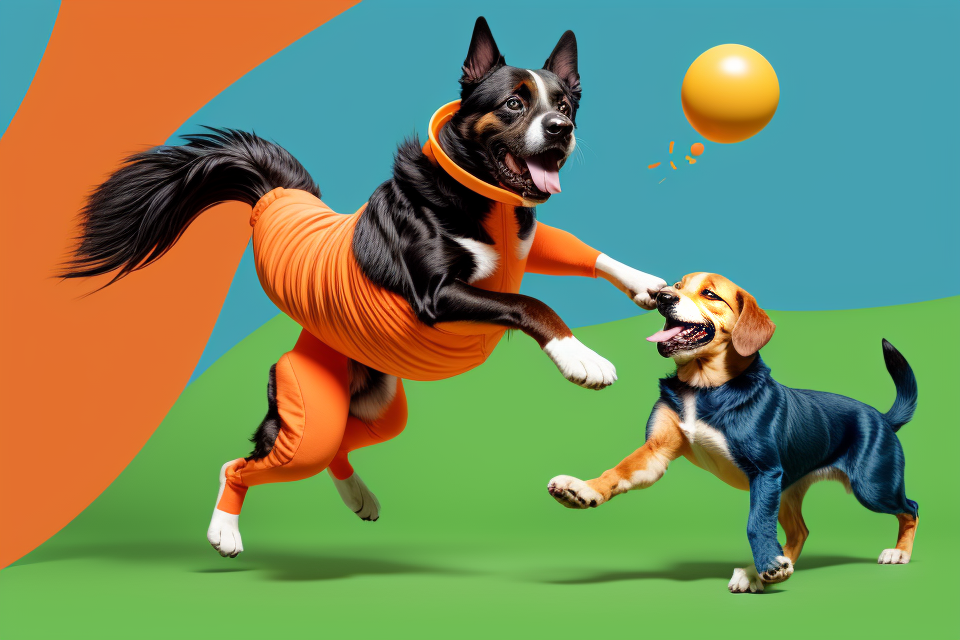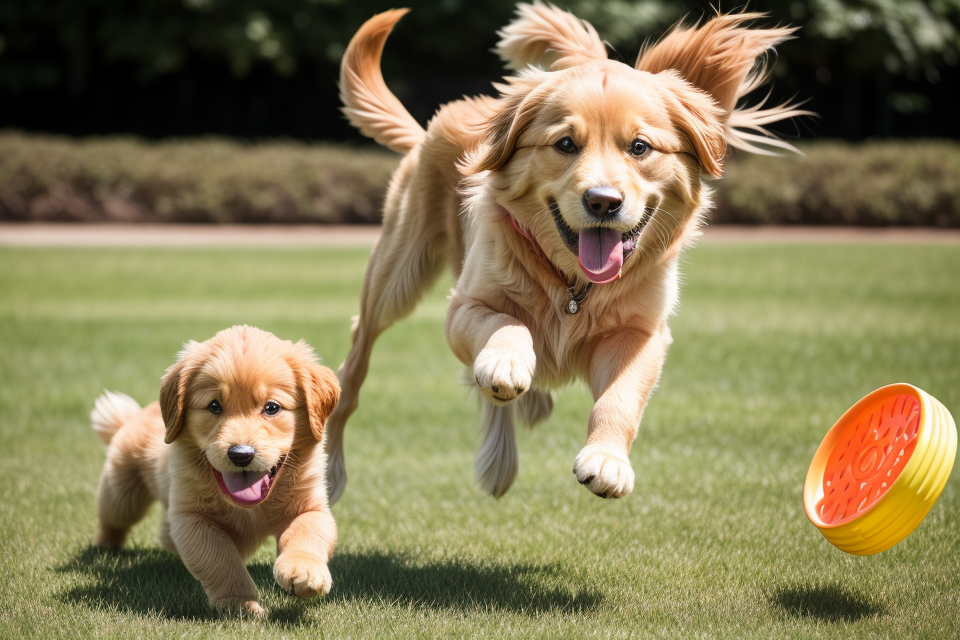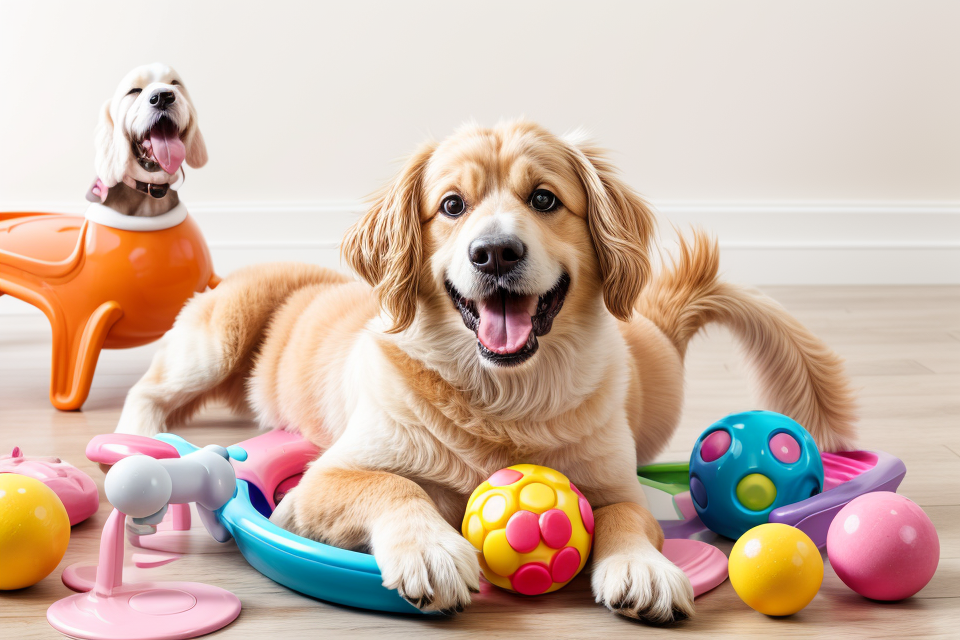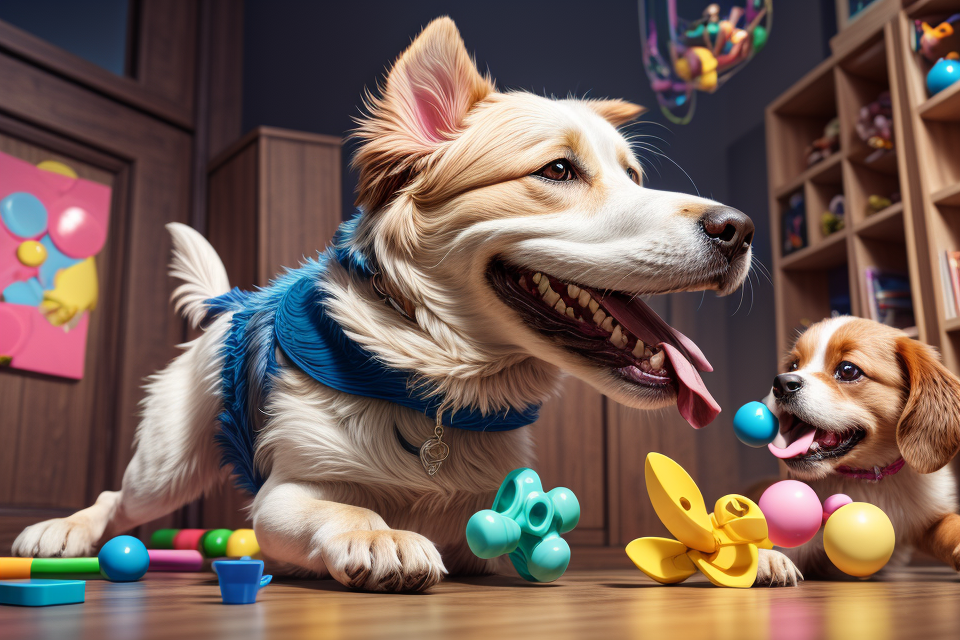Do dogs see toys as prey? This is a question that has been debated among animal behaviorists and dog owners for years. Some argue that dogs view toys as objects to be played with, while others believe that they see them as potential prey. In this exploration of canine playtime behavior, we will delve into the ways in which dogs interact with toys and examine the evidence for and against the idea that dogs see toys as prey. From fetch to tug-of-war, we will look at the various ways in which dogs play with toys and consider what this might reveal about their underlying motivations and cognitive processes. So, buckle up and get ready to explore the fascinating world of dog playtime behavior!
Understanding Canine Playtime Behavior
The Importance of Play in a Dog’s Life
Playtime is a crucial aspect of a dog’s life, as it contributes to their physical and mental well-being. It is through play that dogs can exercise their bodies, improve their cognitive abilities, and develop their social skills. Additionally, playtime also strengthens the bond between dogs and their owners, creating a strong emotional connection that benefits both the dog and the owner.
Physical Benefits of Playtime
Playtime provides dogs with the opportunity to exercise their bodies, which is essential for maintaining a healthy weight and preventing obesity-related health problems. Engaging in physical activity also helps to improve a dog’s cardiovascular health, muscle tone, and flexibility. Playtime can include activities such as fetch, tug-of-war, and running, all of which provide dogs with the physical stimulation they need to stay healthy and happy.
Mental Benefits of Playtime
Playtime is also beneficial for a dog’s mental well-being. It helps to stimulate their minds, improve their problem-solving skills, and enhance their creativity. Playtime can also help to reduce stress and anxiety in dogs, providing them with a positive outlet for their energy and emotions. Additionally, playing with toys can help to satisfy a dog’s natural instinct to hunt and retrieve, which can be mentally stimulating for them.
Social Benefits of Playtime
Playtime is an important social activity for dogs, as it helps them to develop their social skills and build strong bonds with their owners and other dogs. Through play, dogs learn how to communicate, share, and take turns, which are important social skills that they will use throughout their lives. Additionally, playing with other dogs can help to reduce aggression and prevent territorial behavior, as dogs learn to coexist peacefully and playfully.
In conclusion, playtime is a crucial aspect of a dog’s life, providing them with physical, mental, and social benefits that contribute to their overall well-being. It is important for dog owners to provide their pets with regular opportunities for play and exercise, as this will help to ensure that they live long, happy, and healthy lives.
The Role of Toys in Canine Play
Toys play a crucial role in canine playtime behavior, serving as objects that stimulate a dog’s natural instincts. Dogs are predatory animals, and their instinct to hunt is deeply ingrained in their psyche. Toys provide a safe and controlled outlet for this instinct, allowing dogs to engage in play that mimics their natural hunting behavior.
Different types of toys have specific effects on a dog’s behavior. For example, a ball or a frisbee can be thrown and retrieved, simulating the act of catching prey. A stuffed animal or a toy mouse can be stalked, pounced upon, and held in the mouth, just like a real animal.
In addition to providing an outlet for a dog’s natural instincts, toys also serve as a way to strengthen the bond between a dog and its owner. Playing with toys together creates positive associations with the owner and reinforces the dog’s sense of security and belonging.
It is important to note that not all dogs will exhibit the same level of interest in toys, and some may be more attracted to certain types of toys than others. Understanding a dog’s individual preferences and finding toys that match their interests can help enhance the overall play experience.
Overall, the role of toys in canine play is essential for a dog’s physical and mental well-being. By providing a safe and controlled outlet for a dog’s natural instincts, toys can help keep dogs happy, healthy, and engaged in play.
The Debate: Do Dogs See Toys as Prey?
The Argument for Toys as Prey
- The similarities between toys and prey objects from a dog’s perspective
- Both toys and prey objects are small, moveable objects that can be seen as potential sources of food or play.
- Toys may be perceived as “pretend” prey objects, as they are often used in play-hunting games and may be thrown or rolled like a real prey item.
- The ways in which a dog might “hunt” for and “catch” a toy
- Dogs may use their sense of smell to locate a hidden toy, similar to how they might track a real prey item.
- They may also use their sense of sight to stalk and pounce on a toy, just as they would with real prey.
- Some dogs may even use their sense of hearing to locate a toy, similar to how they might locate the sound of a rustling leaf or a scurrying animal.
- Once a dog has located a toy, they may use their teeth and mouth to “catch” it, just as they would with real prey.
- This play-hunting behavior may also serve as a way for dogs to release energy and practice their hunting instincts in a safe and controlled environment.
The Argument Against Toys as Prey
The Differences Between Toys and Prey Objects from a Dog’s Perspective
One argument against the notion that dogs see toys as prey is the differences between toys and prey objects from a dog’s perspective. While both toys and prey objects may be seen as attractive to dogs, they differ in several key ways. For example, prey objects are typically alive and able to move, while toys are inanimate objects that cannot move on their own. Additionally, prey objects are typically associated with the act of hunting and catching, while toys are typically associated with play and interaction with humans.
The Various Factors that can Influence a Dog’s Perception of Toys as Prey
Another argument against the idea that dogs see toys as prey is the fact that various factors can influence a dog’s perception of toys as prey. For example, a dog’s breed, size, and age can all play a role in how they perceive toys. Additionally, a dog’s past experiences and training can also impact their perception of toys as prey. For instance, a dog that has been trained to fetch a specific toy may view that toy as more important or valuable than other toys.
Overall, the argument against toys as prey suggests that while dogs may be attracted to toys, they do not see them in the same way as they do prey objects. Instead, the way that dogs perceive toys is likely influenced by a variety of factors, including their breed, size, age, past experiences, and training.
The Science Behind Canine Playtime Behavior
The Role of the Olfactory System in a Dog’s Play
A dog’s sense of smell plays a significant role in its interactions with toys. This olfactory system is highly developed in dogs, and it enables them to detect and interpret a wide range of scents.
When a dog encounters a toy, it will first use its sense of smell to determine whether the toy is interesting or not. If the toy has a scent that the dog finds appealing, it will likely become more interested in the toy and engage in play.
The ways in which different toy materials and scents can influence a dog’s behavior are complex and multifaceted. For example, a dog may be more attracted to a toy that has a strong scent of roast beef, as this is a scent that is associated with food and may therefore be highly appealing to the dog. On the other hand, a dog may be less interested in a toy that has a scent of lavender, as this scent is not typically associated with food and may therefore be less appealing to the dog.
Furthermore, the texture of the toy can also affect a dog’s behavior. A dog may be more interested in a toy that has a soft, plush texture, as this texture is often associated with comfort and security. On the other hand, a dog may be less interested in a toy that has a hard, rigid texture, as this texture may be associated with discomfort or pain.
Overall, the olfactory system plays a critical role in a dog’s interactions with toys. By understanding how a dog’s sense of smell influences its behavior, pet owners can better choose toys that will be most appealing to their dogs and encourage more enjoyable and engaging playtime.
The Role of Vision in a Dog’s Play
How a dog’s vision can impact its perception of toys
Dogs, like humans, have a binocular vision system, which means they see the world through two eyes that work together to create depth perception. However, dogs have a narrower field of vision compared to humans, which can affect their perception of objects in their environment. For example, dogs have difficulty seeing objects that are far away or directly in front of them, and their visual acuity is much lower than that of humans.
The importance of toy design and color in a dog’s play
One of the key factors that can influence a dog’s perception of a toy is its design and color. For example, toys that are designed to resemble small animals, such as mice or birds, may be more appealing to dogs because they trigger their predatory instincts. Additionally, the color of the toy can also play a role in a dog’s perception of it as prey. For instance, toys that are designed to look like red squirrels or red birds may be more appealing to dogs because of their color alone.
It is worth noting that the perception of toys as prey may also be influenced by a dog’s breed and individual personality. For example, certain breeds, such as terriers, may be more inclined to view toys as prey due to their hunting instincts, while other breeds, such as greyhounds, may be less interested in toys and more interested in other forms of play. Ultimately, the way a dog perceives toys will depend on a combination of factors, including its breed, individual personality, and environmental factors.
Training Your Dog to Play with Toys
The Benefits of Toy Training
Training your dog to play with toys can have numerous benefits for both you and your furry friend. By teaching your dog to play with toys instead of your belongings or other items in the house, you can prevent destructive behavior and keep your home safe and tidy. Additionally, toy training can help improve your dog’s behavior in other areas, such as reducing barking and improving leash manners.
One of the most significant benefits of toy training is that it provides a positive outlet for your dog’s natural instincts. Dogs are naturally inclined to chase and retrieve objects, and playing with toys allows them to satisfy these instincts in a safe and appropriate way. This can help reduce the likelihood of your dog engaging in destructive behavior, such as chewing on furniture or shoes.
Toy training also provides an opportunity for you to strengthen your bond with your dog. Playing with toys together can be a fun and rewarding experience for both you and your dog, and it can help improve communication and trust between you and your furry friend.
Finally, toy training can be an effective tool for managing your dog’s energy levels and preventing hyperactivity. By providing your dog with appropriate toys and encouraging playtime, you can help tire them out and reduce the likelihood of them becoming overly excited or destructive.
Overall, the benefits of toy training are numerous and can have a positive impact on both you and your dog’s behavior and well-being. By teaching your dog to play with toys, you can provide a safe and positive outlet for their natural instincts, strengthen your bond, and manage their energy levels.
Tips for Successful Toy Training
Choosing the right toys for your dog
Selecting the appropriate toys for your dog is crucial to encourage positive play behaviors. Consider the following factors when choosing toys:
- Durability: Opt for toys that can withstand your dog’s playstyle and teeth.
- Size: Choose toys that are appropriately sized for your dog to prevent choking or swallowing.
- Material: Select toys made from non-toxic, durable materials that are safe for your dog to chew and play with.
- Type: Offer a variety of toys, such as plush, rope, or rubber, to cater to different play preferences.
Establishing a routine for playtime and toy training
Creating a consistent routine for playtime and toy training helps your dog understand what to expect and develop good habits. Follow these steps to establish a routine:
- Set aside a specific time each day for playtime and toy training.
- Gradually increase the duration of playtime sessions as your dog becomes more engaged.
- Alternate between different types of toys to keep playtime interesting and stimulating.
- End each play session on a positive note by praising your dog and offering a reward or treat.
Encouraging healthy, fun play behaviors
To foster positive play behaviors, it’s essential to encourage your dog to interact with toys in the desired manner. Here are some tips:
- Supervise playtime: Monitor your dog’s behavior and intervene if they become too aggressive or possessive with the toys.
- Offer high-value rewards: Use treats or praise to reinforce good play behaviors and discourage undesirable actions.
- Initiate play: Start play sessions by encouraging your dog to pick up and play with a toy, and gradually phase out your involvement.
- Rotate toys: Regularly swap out toys to keep playtime engaging and to prevent your dog from becoming bored or repetitive in their playstyle.
Providing a Safe and Stimulating Play Environment for Your Dog
Creating a Play Space for Your Dog
When it comes to providing a safe and stimulating play environment for your dog, creating a designated play area is a crucial step. A dedicated play space allows you to control the environment and ensure that your dog’s playtime is safe, engaging, and enjoyable. Here are some tips for setting up a play space that meets your dog’s needs:
The Importance of a Designated Play Area for Your Dog
Dogs are naturally curious and active animals, and they need a variety of stimuli to keep them engaged and entertained. Providing a designated play area for your dog gives them a safe space to exercise their natural instincts, develop their skills, and have fun. A play area also helps to prevent destructive behavior and keeps your dog’s toys and other belongings organized and accessible.
Tips for Setting Up a Safe and Stimulating Play Space
- Choose a location that is safe and accessible for your dog. A fenced-in yard or a designated room in your home are both good options.
- Make sure the play area is free from hazards such as sharp objects, breakable items, and dangerous chemicals.
- Provide a variety of toys and playthings that appeal to your dog’s natural instincts, such as stuffed animals, balls, and ropes. Rotate the toys regularly to keep playtime interesting.
- Consider adding features such as obstacles, tunnels, or climbing structures to challenge your dog and keep them engaged.
- Provide plenty of fresh water and a comfortable place for your dog to rest and recover from playtime.
By creating a designated play space for your dog, you can provide a safe and stimulating environment that meets their needs and helps to prevent destructive behavior.
Keeping Your Dog Engaged During Playtime
One of the most important aspects of playtime with your dog is keeping them engaged and interested in the activities and toys you provide. A bored dog is likely to become destructive or disruptive, so it’s essential to keep playtime fresh and stimulating. Here are some tips for keeping your dog engaged during playtime:
- Offer a variety of toys: Dogs are naturally curious, and they will be more interested in playtime if there are a variety of toys to explore. Rotate your dog’s toys regularly to keep things interesting, and consider investing in a variety of different types of toys, such as squeaky toys, rope toys, and plush toys.
- Mix up the playstyle: Dogs enjoy a mix of playstyles, including solo play, interactive play, and independent play. Try alternating between different types of play throughout the day to keep your dog engaged and entertained.
- Provide mental stimulation: In addition to physical play, it’s important to provide mental stimulation for your dog. This can include puzzle toys, scent work, and interactive games that challenge your dog’s brain.
- Make playtime a part of routine: Dogs thrive on routine, so make playtime a regular part of your daily routine. This will help your dog anticipate and look forward to playtime, making it more enjoyable for both you and your dog.
By following these tips, you can help ensure that your dog stays engaged and entertained during playtime, which will help to strengthen your bond and keep your dog happy and healthy.
The Future of Canine Playtime Behavior Research
Current Trends in Canine Playtime Behavior Research
The impact of technology on canine playtime behavior
- In recent years, technology has played a significant role in advancing our understanding of canine playtime behavior.
- With the help of innovative tools such as slow-motion cameras, infrared thermography, and computer simulations, researchers are now able to study canine playtime behavior in greater detail than ever before.
- For example, researchers at the University of California, San Diego, used high-speed cameras to analyze the movements of dogs during playtime, revealing the intricacies of their hunting-like behavior.
- These technological advancements have allowed researchers to gain new insights into the ways in which dogs interact with toys, providing valuable information for training and behavior modification.
The importance of continued research in this field
- As our understanding of canine playtime behavior continues to evolve, it is crucial that we continue to conduct research in this area.
- By studying the behavior of dogs during playtime, we can gain a better understanding of their cognitive abilities, social dynamics, and emotional well-being.
- This knowledge can then be used to develop more effective training methods, improve the quality of life for our pets, and promote positive interactions between dogs and their owners.
- Additionally, continued research in this field can help to shed light on the complex relationship between dogs and their toys, potentially leading to new and innovative ways to enrich their playtime experiences.
- In conclusion, the future of canine playtime behavior research is bright, and we can expect to see continued advancements in our understanding of this fascinating subject in the years to come.
Areas for Future Research
Investigating the impact of different training methods on canine playtime behavior
While positive reinforcement has been shown to be an effective training method for canines, it is important to explore other methods and their impact on canine playtime behavior. For example, the use of punishment-based methods may result in increased aggression during playtime or a decrease in playful behavior altogether. Future research could investigate the long-term effects of various training methods on canine playtime behavior and determine the most effective methods for promoting positive and safe play.
Exploring the long-term effects of playtime on a dog’s physical and mental health
Playtime is essential for a dog’s physical and mental well-being, but there is still much to be learned about the long-term effects of playtime on a dog’s health. For example, some research suggests that playing fetch may have negative effects on a dog’s joints, while other studies have found that playing with toys can improve cognitive function in older dogs. Future research could investigate the long-term effects of different types of playtime on a dog’s physical and mental health and provide guidance for owners on how to promote healthy playtime behaviors.
The potential for cross-species play and the benefits for both dogs and humans
While dogs and humans have different play styles, there is potential for cross-species play that could benefit both dogs and humans. For example, dogs have been shown to be able to play with robotic toys that simulate human behavior, and playing with dogs has been shown to have benefits for human physical and mental health. Future research could investigate the potential for cross-species play and the benefits for both dogs and humans, as well as the development of new technologies and toys that facilitate cross-species play.
FAQs
1. Do dogs see toys as prey?
Dogs do not see toys as prey in the same way they see live animals as prey. However, dogs have a natural instinct to chase and catch things, which can include toys. Many dogs will bring their toys to their owners and drop them at their feet, which can resemble the behavior of bringing prey to their owners.
2. Why do dogs play with toys?
Dogs play with toys for a variety of reasons. Playing with toys can satisfy their natural instinct to chase and catch things, as well as provide mental stimulation and relief from boredom. Toys can also help satisfy a dog’s desire for social interaction and affection from their owners.
3. How do dogs choose which toys to play with?
Dogs often choose toys that are similar in size, shape, and texture to live prey. Toys that make noise or have a strong odor can also be appealing to dogs. Some dogs may also have favorite toys that they prefer to play with over others.
4. Can dogs differentiate between toys and real prey?
Dogs can differentiate between toys and real prey, but it may depend on the individual dog and the context of the situation. Some dogs may become confused or frustrated if they cannot tell the difference between a toy and a real animal, while others may be able to easily distinguish between the two.
5. How can I encourage my dog to play with toys?
There are several ways to encourage your dog to play with toys. Providing a variety of toys with different textures, sizes, and shapes can help keep your dog interested. You can also try hiding treats or encouraging play by throwing or rolling the toy for your dog. Additionally, playing with your dog and providing plenty of praise and affection can help motivate them to play with toys.



